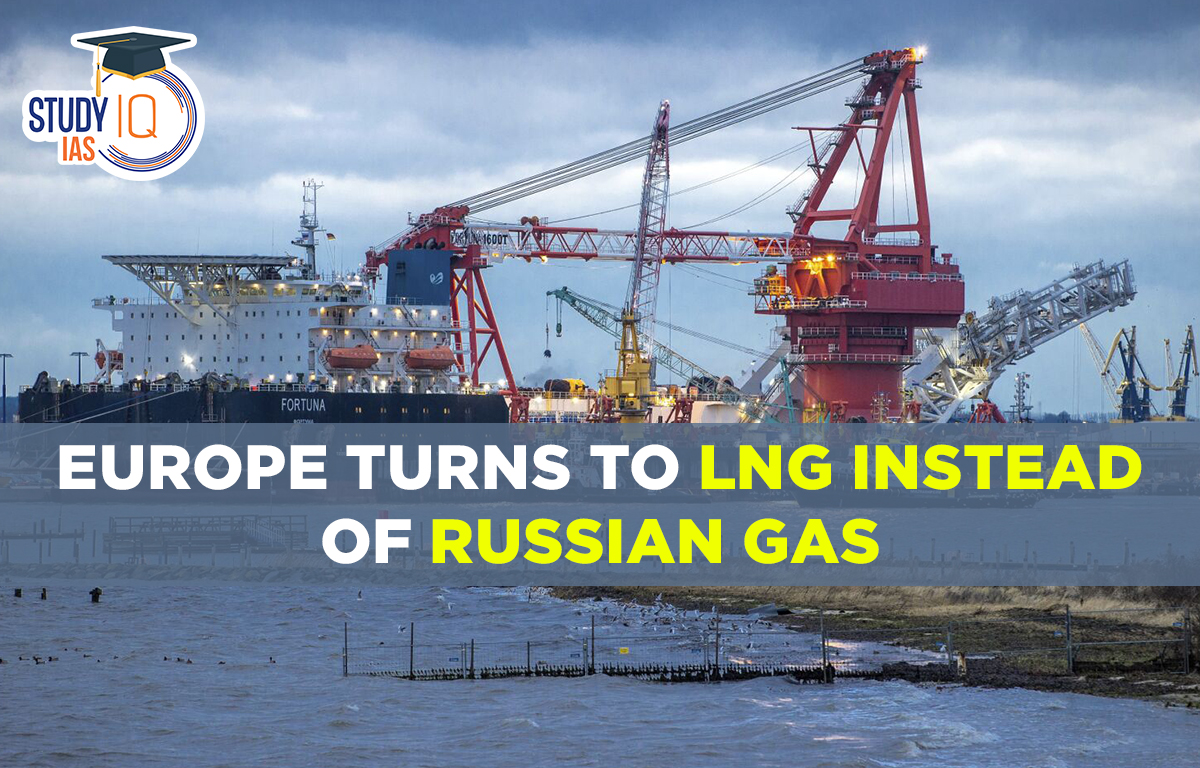Table of Contents
Europe Turns to LNG Instead of Russian Gas Background
- Amid the Russia-Ukraine War, the European Union (EU) banned 90% of Russian crude oil imports in 2022.
- This was to dent the Russian economy.
- The Russian economy has been heavily dependent on energy exports, with the EU paying billions of dollars every month to Russia for its crude and refined products.
- The EU wanted to block this massive revenue inflow that was akin to Europeans bankrolling Russia’s war.
- Presently, the EU is increasing the import of liquified natural gas from the US to compensate for lost Russian gas supplies.
- Soon the LNG tankers carrying fracked US gas will be landing in northern Germany.
- With this move, the EU has become the biggest LNG importer in the world.
Europe’s Dependence on Russia for Natural Gas
- Russia is the biggest supplier of natural gas to Europe, which depends on the former for nearly 40% of its natural gas requirements.
- Russia is followed by Norway, which supplies about 22% of Europe’s gas needs; Algeria and Azerbaijan supply under 20% and 10% respectively.
- About one-fifth of the European Union’s energy demand is met by natural gas, which makes gas the continent’s second largest source of energy.
- Natural gas makes up about 20% of the continent’s electric power generation.
- Germany, Europe’s largest economy, depends on Russia for 65% of its natural gas needs, while Italy gets 43% of its gas from Russia, and France, a little over 16%.
What is Liquified Natural Gas (LNG)?
- LNG is natural gas reduced to a liquid state i.e liquefaction through intense cooling to around -161 degrees Celsius (-259 Fahrenheit).
- This liquid gas is 600 times smaller than the original volume and is half the weight of water.
- Gas liquefaction involves cooling gas to a temperature below its boiling point so that it can be stored and transported in its liquid phase.
- The compressed fossil fuel is constituted almost wholly of methane, a potent greenhouse gas.
- Advantages: LNG is a way to move natural gas from producing regions to markets where natural gas pipelines are not feasible or do not exist such as to and from the United States and other countries.
- Asian countries combined account for the largest share of global LNG imports.
- It can be transported around the world by ship.
- It has a high export potential and as a central fuel for the transport sector is an excellent substitute for conventional fuels.
- LNG in its liquid form can be used in the marine and mining sectors as fuel.
- LNG has a higher energy density, which means more energy can be stored and transported for the same amount of volume.

Limitations of LNG
- Energy Requirement: LNG has high operating and infrastructure costs. A lot of energy is required to extract, transport, cool and regasify LNG.
- Methane Loss: Between 10-25% of the energy of the gas is lost during the liquefaction process.
- Consequently, the risks of methane leakages along the production, transport and regasification chain are high and therefore much more emissions-intensive.
- High Emissions: LNG emits about twice as much greenhouse gas as ordinary natural gas.
- Climate Risk: With LNG creating almost 10 times more emissions than piped gas by one estimate, its rapid expansion might compromise climate targets.
- Expansion of LNG exports and increased reliance on imported gas will lock in fossil fuel dependence at the expense of already feasible and cost-competitive cleaner energy technologies.
- The economic costs of the climate change impacts from U.S. LNG-related export costs that are borne by the public could exceed $30 billion per year by 2030.
- According to some think tanks, the new planned terminals in Germany could expand capacity by two-thirds above what the nation consumes.
- This would be in conflict with Germany’s national climate targets and would constitute a breach of national legislation and international commitments under the Paris Agreement.

- Green Hydrogen: According to some think tanks, the floating LNG terminals going online in Europe cannot be adapted into infrastructure for green hydrogen. LNG Terminals are classically fossil-fuel plants that are not good for climate protection.
- Green hydrogen is defined as hydrogen produced by splitting water into hydrogen and oxygen using renewable electricity.
Way Forward
- Promoting energy efficiency and renewable power is the sustainable solution to the shortfall in Russian gas.
- Emphasis should be laid on cheaper sustainable energy sources to make up the current gas deficit.
- Governments should develop and implement strategies to effectively curtail Methane leakage.


 Daily Quiz 05 July 2025
Daily Quiz 05 July 2025
 SSC MTS Apply Online for 1075 Posts – ...
SSC MTS Apply Online for 1075 Posts – ...
 Dynamic Pricing: What It Is and Why It's...
Dynamic Pricing: What It Is and Why It's...





















